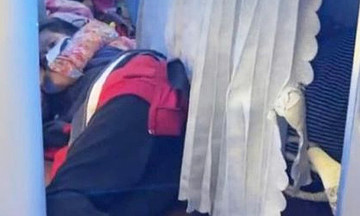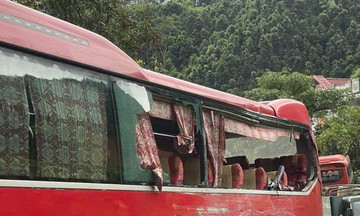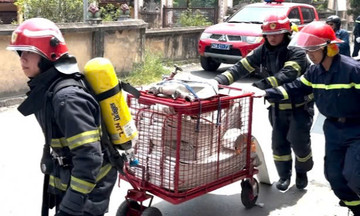On 14/8, the General Staff of the Vietnam People's Army held a scientific conference to commemorate its traditional day, with the theme "80 years of construction, combat, and growth, stepping firmly into the nation's new era".
Presenting a paper on the formation and development of the General Staff, Colonel Nguyen Van Binh, an expert from the Institute of Strategy and Military History of Vietnam, said that after the August Revolution of 1945, the Democratic Republic of Vietnam was born amidst myriad difficulties. The fledgling government faced the threat of both internal and external enemies.
The Party Central Committee and President Ho Chi Minh advocated for the rapid development of the armed forces, including the urgent establishment of a strategic staff agency to assist the Party and the Government in commanding military activities nationwide. At the suggestion of General Vo Nguyen Giap, on 7/9/1945 at the Presidential Palace, President Ho Chi Minh assigned the task of establishing the military staff agency to Hoang Van Thai.
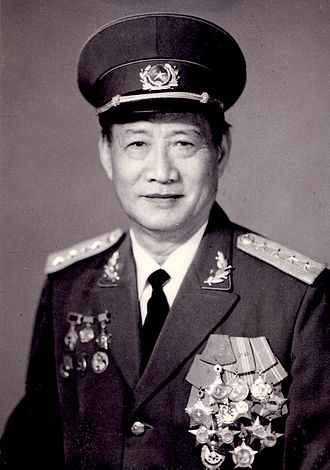 |
General Hoang Van Thai. Photo archive |
General Hoang Van Thai. Photo archive
Hoang Van Thai (birth name Hoang Van Xiem) was born in 1915 in An Khang village, Dai Hoang district (now Tay An commune, Tien Hai district, former Thai Binh province). At the age of 18, he joined the workers' movement; at 23, he was admitted to the Indochinese Communist Party. In 1944, he joined the Vietnam Propaganda Liberation Army, in charge of intelligence and combat operations.
Recognizing Hoang Van Thai's capabilities, President Ho Chi Minh appointed him as Chief of Staff, assigning him the task of establishing the General Staff to assist the Party Central Committee and the Government in leading and commanding the armed forces. The General Staff "is a confidential military agency of the Party, important to the Army. Its main task is to organize and train the army well; to understand the enemy and ourselves clearly; to devise clever strategies; and to organize command smoothly, secretly, quickly, timely, and accurately to defeat all enemies and protect the revolution".
Built from scratch
Colonel Nguyen Van Binh said that General Thai accepted the task with no staff officers, no resources, and no workplace. He kept in mind President Ho Chi Minh's words: "Making a revolution requires both doing and learning. It's difficult at first, but with determination, any difficulty can be overcome".
On 7/9/1945, he met with 8 officers to explain President Ho Chi Minh's directives and discuss immediate tasks. These were the "first bricks" laid for the foundation of the Army's staff agency. He asked the officers to utilize their knowledge to build the agency, maintain absolute secrecy about the organization and its work, and build strong relationships with compatriots and comrades.
After many days and nights of studying documents and seeking input from officers in various units, General Thai outlined the basic organizational structure of the staff agency, including the following departments: Operations - Cartography; Intelligence; Communications; and Office.
The Operations - Cartography Department faced difficulties with limited resources and information while the war in the south escalated. The department had to handle conflicts and sabotage flexibly, contributing to thwarting the plots of the French and their henchmen, protecting and consolidating the revolutionary government.
The Communications Department organized radio and telegraph networks; implemented cryptography; and opened training courses for the war zones. By the end of 9/1945, War Zones 1, 2, and 3, and several key provinces were able to communicate with the Central Committee by radio. The Communications Department completed the radio communication system with the south; Military Zone 5; War Zones 1, 2, and 32. The "special liaison" team's land-based document delivery system began operating on several main routes connecting Hanoi, Vinh, Hue, Military Zone 5, Hai Phong, Lang Son, and Lao Cai. Secure and smooth communication was ensured from the Central Committee to units and localities.
In the context of continuous attacks against the revolution, General Thai assessed the urgent need to build a system of well-trained, highly capable intelligence officers. He requested the Intelligence Department to provide intensive training in intelligence for officers and personnel, and to develop intelligence bases to monitor the enemy. The task was to focus on key areas and locations, such as border regions and important transportation routes; any developments, plots, or schemes required countermeasures.
Intelligence officers were sent to the grassroots level to gather information on troop strength and weaponry. This formed the basis for the General Staff to direct the development, organization, staffing, production, procurement of weapons, and training of forces. "Under the direction and guidance of General Hoang Van Thai, the General Staff gradually stabilized its organization, staffing, and facilities, deploying activities according to its functions and tasks, achieving high efficiency", Colonel Binh emphasized.
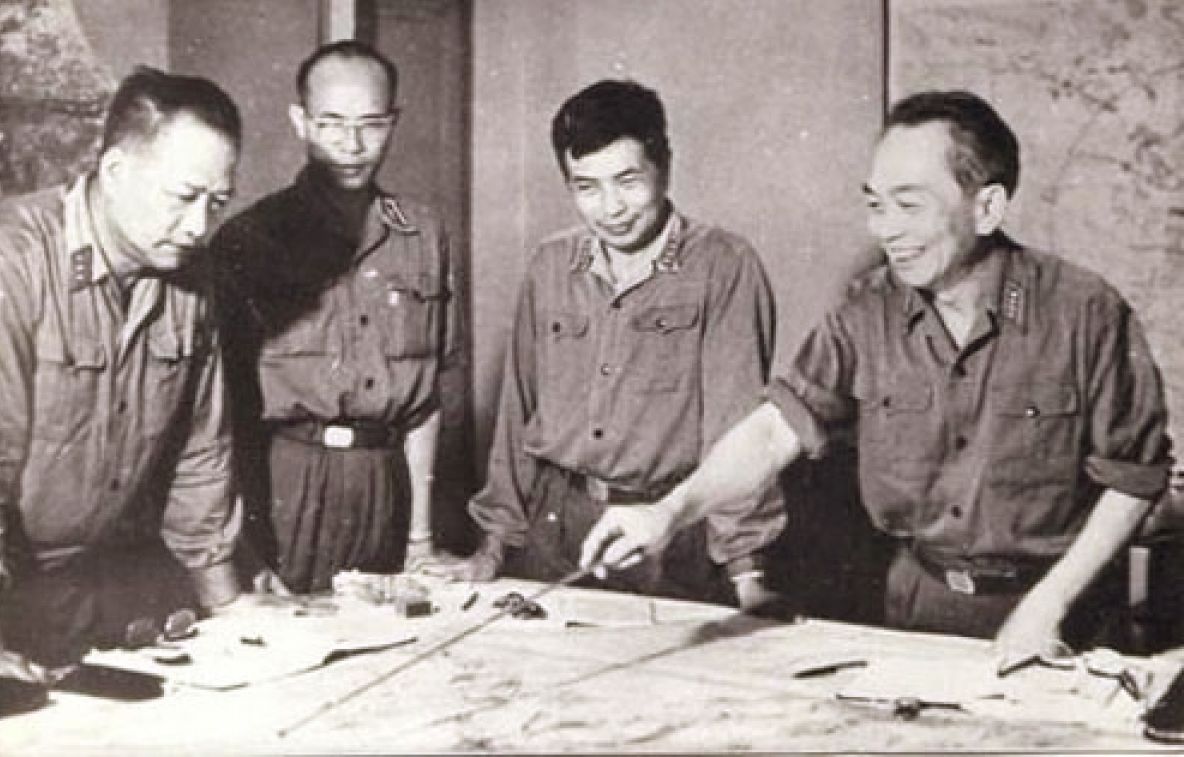 |
General Vo Nguyen Giap, Senior Lieutenant General Hoang Van Thai and other generals directed and monitored combat during the 1975 Spring General Offensive and Uprising. Photo archive |
General Vo Nguyen Giap, Senior Lieutenant General Hoang Van Thai and other generals directed and monitored combat during the 1975 Spring General Offensive and Uprising. Photo archive
Role in major campaigns
The Viet Bac Autumn-Winter 1947 victory defeated the French "quick strike" plan, bringing the resistance war into a period of balanced forces. However, France, aided by the US, implemented the Revers Plan to expand its occupation and blockade the border. The General Staff proposed to the Central Military Commission and the Party Central Committee's Standing Committee to launch a major offensive in 1950 to gain strategic initiative on the battlefield and move the resistance war into a general counter-offensive phase.
The General Staff recognized the strength of the enemy in the Northeast with its numerous outposts. However, the Vietnamese army had advantages in logistics and receiving aid. Victory in this theater would create a major shift in the overall war situation. In early 7/1950, the Party Central Committee and the Central Military Commission decided to shift the strategic offensive to the Northeast based on the General Staff's report. General Hoang Van Thai directly supervised the drafting of the "Le Hong Phong II Campaign" plan.
The initial plan was to attack the enemy in Cao Bang, but after reconnaissance, General Vo Nguyen Giap, the campaign commander, chose Dong Khe as the opening target, following the principle of "attacking small outposts first, then large ones; attacking fortifications first, then maneuvering to annihilate reinforcements".
The actual course of the campaign demonstrated the correctness and soundness of this plan. French General Marchand, who commanded that battle, acknowledged that the Vietnamese army had a firm combat doctrine. "They conducted successive battles, linked together coherently, and left the French breathless over a large area from Dong Khe to That Khe", quoted from Marchand's Indochina Tragedy.
"The Border Campaign marked the maturation of a strategic staff agency, from guerrilla warfare to concentrated large-scale attacks, joint-arms operations of increasing scale", Chief of the General Staff Hoang Van Thai assessed at the Campaign Summary Conference in 1950.
 |
General Phan Van Giang, Minister of National Defense. Photo: Hoang Phong |
General Phan Van Giang, Minister of National Defense. Photo: Hoang Phong
Contributing to "earth-shattering" victories
General Phan Van Giang, Minister of National Defense, emphasized that the General Staff has made significant contributions to "earth-shattering" victories such as the 1968 Tet Offensive, the 1972 strategic offensive, the "Hanoi - Dien Bien Phu in the Air" victory in 1972, and the 1975 Spring General Offensive and Uprising.
After reunification, the General Staff focused on advising the Central Military Commission and the Ministry of National Defense on military and defense policies; directing the adjustment of strategic deployments, consolidating reserve forces, building strong defense zones; and developing plans for the development of armed forces based on the people's war doctrine, combining socio-economic development with national defense consolidation, especially in remote areas, borders, and islands.
During the renovation period, the General Staff has promoted research and forecasting, advising on building a "revolutionary, regular, elite, and gradually modern" Vietnam People's Army; implementing force modernization, strengthening national defense potential, preparing forces for combat readiness, and meeting the requirements of national defense in all situations.
Son Ha







